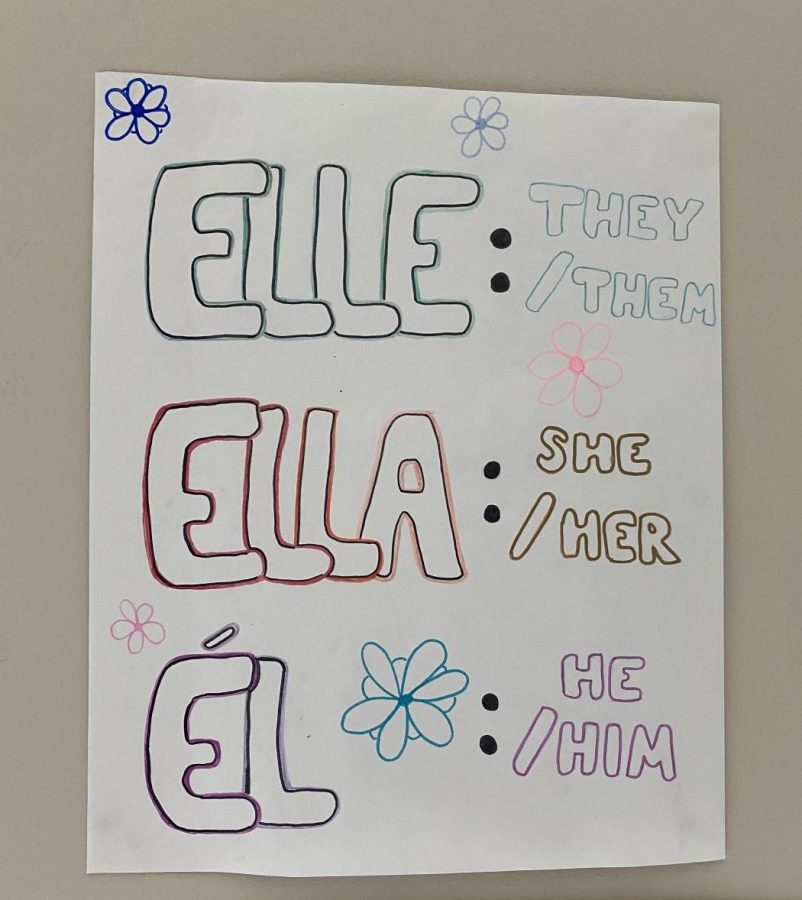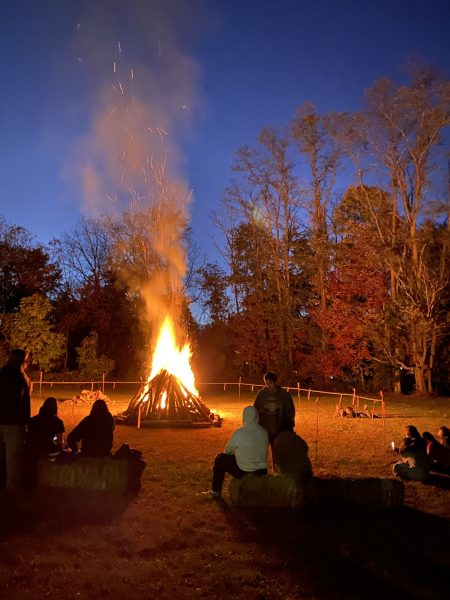RHS Students Call for Gender Neutral Pronouns in World Language Classes
Pronoun posters in Mr. Fisher’s classroom make it clear that students have access to inclusive language.
Change is often glacial in education, but in the past few years students at RHS have taken matters into their own hands.
Students have done everything from calling for vending machines in the lunch rooms this winter to peacefully gathering to support the Black Lives Matter movement in 2020 to protesting hateful acts in our school in 2021.
RHS is bursting with bright young folks ready to make the world a better place.
Most recently, Gender Equity Club, Spanish Club, and French Club have been endeavoring to make RHS more inclusive for all by educating themselves and others about gender neutral language options in English, Spanish, and French.
Language is a vital part of culture. It allows us to connect with others, express ourselves, and understand the world around us. We depend upon it as a tool of communication and understanding, so when it fails us it can be alienating and scary.
In an article for The Atlantic, journalist Annabelle Timsit writes about early 20th century linguist Edward Sapir who put forth the idea that “Language determines and constrains what you’re capable of thinking.”
In other words, the theory claims that you are not able to say something if you are not able to think it. Though this hypothesis was later questioned by other linguists, it still highlights the importance of language in conveying how we feel and who we are.
Pronouns are an essential component of many languages as they allow people to express themselves and their identity.
Linguist Roman Jakobson explains the importance of gender neutral pronouns through a Neo-Whorfian lens, “It’s not that speaking French makes it impossible for you to conceive of something as gender neutral… but that the language forces you to think often in gendered terms.”
This necessitates student access to pronouns that reflect their identity all the time, in all languages. Students at RHS have aptly recognized that it is also important that people can use gender neutral pronouns in world language classes.
In English, referring to people with gender neutral pronouns is fairly easy; you just use the gender neutral “they.” But in other languages it is not so simple, even if there are gender neutral pronoun options, because other languages have gendered adjectives and nouns.
Though many world languages have not formally decided how to incorporate gender neutral terms, and often the available options are not widely used, our school’s Gender Equity Club has taken the initiative to make gender neutral pronouns available to all students.
A few weeks ago a swarm of eager changemakers crammed into the Spanish room for a joint meeting of Spanish Club and Gender Equity Club with the goal of educating students and staff about gender neutral pronouns in Spanish.
Spanish teacher and RHS alumnus, Matt Fisher stated that the usage of gender neutral pronouns is still very much evolving in Spain.
“Non-binary individuals use an E rather than the typical use of an O for masculine/male/he/him and A for feminine/female/she/her,” said Fisher.
An example would be as follows: Ella es alta. (She is tall.) El es alto. (He is tall.) Elle es alte. (They are tall.) Using the E for the subject ‘they’ (singular non-binary gender) and an E for the matching adjective.
Spanish Club members have made signs displaying the masculine, feminine, and gender neutral pronouns in Spanish.
In French, solutions to gendered language are not so simple. While in Spanish it’s easy to provide a neutral ending to verbs and nouns by creating a third ending with “e,” this isn’t possible in French, as “e” is already an ending.
Secondly, French speakers are notoriously protective of their language and wish to keep it “pure.” The L’Académie Française, an organization consisting of 40 members dedicated to matters pertaining to the French language, has strongly spoken out against the usage of gender neutral language.
The Academy issued a statement saying that “Faced with this ‘inclusive’ aberration, the French language is now in mortal danger, a fact which our nation is now accountable to future generations.”
Lack of gender neutral options in the French language has made it difficult to offer gender neutral options in French classes.
However, French club members and adviser Sarah Wheeler are enthusiastically following Spanish Club’s lead, and have been meeting with Gender Equity Club for guidance on how to make French classes at RHS more inclusive. They are planning to make informational posters displaying French gender neutral pronouns.
These posters are an essential step on the road to inclusivity as RHS French student Margaux Epter says that when she has been curious about gender neutral options none have been offered to them.
“Not having that option makes it a little uncomfortable in class, especially when we have to write paragraphs about ourselves,” said Epter.
Luckily, despite challenges presented by the language itself, most teachers are enthusiastic about incorporating inclusive language into their curriculum.
“As a mother of a gay son, I know what kids have to deal with in school when they don’t know if their identities will be acknowledged or accepted”, said Middle school French teacher Madame Peterson.
“To be able, as a teacher, to be inclusive and have the students know that I accept and love them and who they are is important to me” said Peterson.
Despite challenges presented by the languages themselves and Language Academies, Peterson, other World Language teachers, and the RHS Gender Equity Club have aptly recognized that people don’t leave their identities at the door of language classrooms.
RHS Community members are not alone in their realization, the use of inclusive language is required by the New York State Department of Education, not just in World Language classes, but in all classes.
It is every RHS teacher’s duty to make sure that each and every student feels supported when it comes to using gender neutral pronouns.





